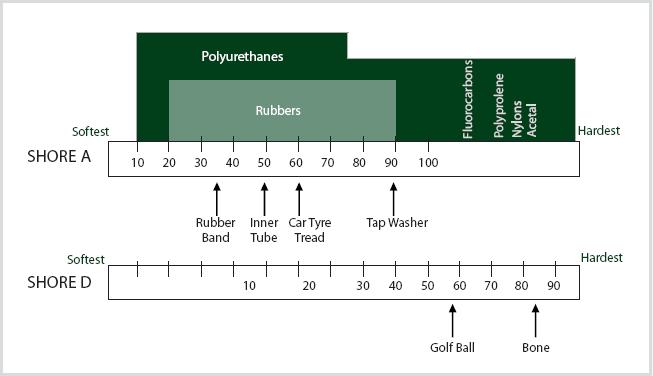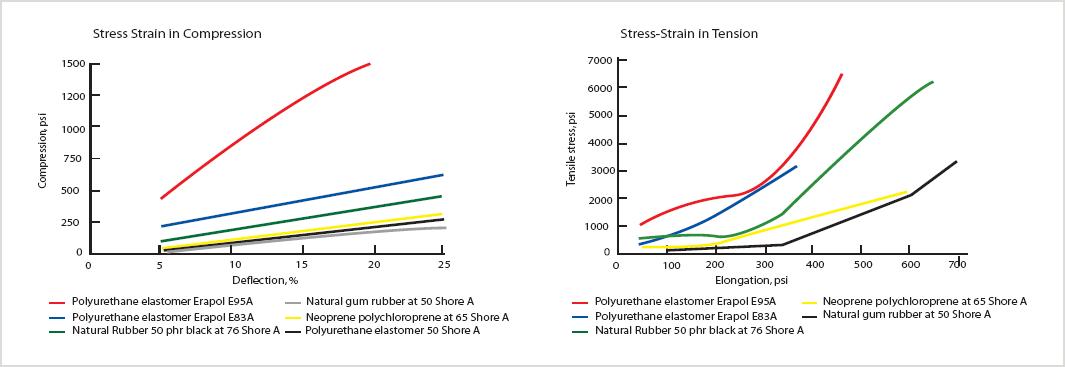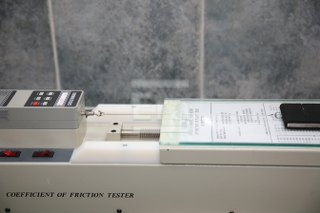1. HARDNESS
The most common method for classifying polyurethanes is according to their hardness, which is measured on a durometer. Erapol elastomers offer a very wide hardness range in which items can be produced, ranging from 10-15 Shore A to over 90 Shore D.
2. ABRASION RESISTANCE
In applications where severe wear is a problem, Erapol elastomers offer outstanding durability when compared with rubber plastics or even metals. In many applications the unusual combination of properties has made it possible to design and fabricate products from Erapol Elastomers using less material than has been possible with other elastomers.
It should be emphasised, however, that abrasion resistance is a complex property. Selection of the most suitable Erapol elastomer should be based on actual experience or simulated service tests.
Era Polymers is able to conduct abrasion testing using the DIN and TABER methods, using the relevant testing machine shown.
3. COMPRESSION PROPERTIES
Erapol elastomers have greater load-bearing capability than conventional elastomers of equal hardness. This capacity is an important advantage in some designs, eg. stripper springs, whilst in others it is the very factor which makes them possible. In addition to high load bearing properties in both tension and compression, Erapol elastomers have a high shear load bearing capacity.
4. MECHANICAL PROPERTIES
At lower hardness levels practically all elastomeric materials, including Erapols, merely bend under impact. As conventional elastomers are compounded up to higher hardness they tend to lose elasticity and crack under impact. On the other hand, Erapol elastomers even at their highest hardness levels, have significantly better impact resistance than almost all plastics.
5. TENSILE PROPERTIES
Erapol elastomers are characterised by high elongation, high tensile strength and high modulus. This provides a combination of toughness and durability in fabricated parts.
The tensile test is normally carried out on a tensile testing machine. In this test we are not only interested in the overall stress-strain curve, but also the shape of the curve and the ultimate elongation, as these also provide valuable information eg. A high elongation at break, a long rubbery plateau followed by a steep rise to break indicates a high toughness.
6. TEAR STRENGTH
Tear Strength together with a high split tear, is a strong indication of toughness.
In actual use, especially in impingement abrasion applications, high tear strength is important. Erapol elastomers have a distinct advantage in this application over conventional rubber.
To test the Tear Strength of a material you use the Istron Machine is used for more information on this click here.
7. RESILIENCE
Resilience in conventional rubbers is generally a function of hardness. This often undesirable relationship does not hold true with Erapol elastomers. Formulations are available in a very wide range of resilience.
For very shock-absorbing uses, low rebound compounds are usually used. eg rebound values of 10-40%. For high frequency vibrations or where quick recovery is required, compounds in the 40-65% rebound value, are used.
In general, toughness is enhanced by resilience. For more information on Resilience Testing click here.
8. FLEX PROPERTIES
Erapol elastomers resist cracking under repeated flexing. As with any elastomer, the rate of cut growth under flexing may be reduced by decreasing the thickness of the part. Unlike other elastomers however, Erapol elastomers can be used practically in very thin sections because of their strength and toughness.
9. LOW TEMPERATURE PROPERTIES
Many Erapol elastomers remain flexible at very low temperatures and possess outstanding resistance to thermal shock. The low temperature resistance of Erapol’s has led to many applications in below 0oC(32oF) conditions.
10. DRY HEAT RESISTANCE
Whilst many Erapol elastomers are only suitable for continuous operation up to 90oC (194oF), intermittent use up to 120oC (248oF) is possible, with some specially formulated materials, continuous operation up to 120oC or even higher can be achieved. Advice on the most suitable material for any particular application should be sought from our Technical Service personnel.
11. WATER RESISTANCE
Depending on the type, Erapol polyether backbone elastomers are very resistant to the effects of water immersion and have excellent long-term stability in water up to 50oC (122oF). Continuous use in hot water over 80oC (176oF) is not recommended.
Water absorption is very low, in the range of 0.3-1% by weight and volume swell is negligible. For example, Erapol elastomers can operate at close tolerance in water lubricated bearings without fear of seizure.
12. ELECTRICAL PROPERTIES
Some Erapol’s have very good insulating properties and are used in many potting and encapsulating applications.
13. OXYGEN AND OZONE RESISTANCE
Products made from Erapol’s are highly resistant to degradation by atmospheric oxygen and ozone. Tests on samples, aged over 500 hours in an atmosphere containing 3ppm ozone, show no attack even while under 20% strain. Past experience has shown that materials which resist this concentration for several hundred hours are virtually immune to attack by normal atmospheric concentrations.
This makes Erapol’s highly successful when employed around electrical equipment, without the hardening and cracking often experienced with conventional elastomers, and indeed, many plastics.
14. OIL GREASE AND CHEMICAL RESISTANCE
Whilst many rubbers and plastics have excellent resistance to one or more specific solvents, oils or chemicals, the wide resistance of Erapol’s to chemical attack means that they can be used in a multitude of environments with the exception of strong acids and alkalis and certain strong solvents.
As with all materials being examined for oil and chemical resistance, it is best to place a sample of the material in actual service. If this is not practical, tests should be devised which simulate actual service conditions as closely as possible.
For specific information on chemical resistance, please consult the Chemical Resistance Chart.
15. RADIATION RESISTANCE
Erapol elastomers are considered to have the best resistance to gamma ray radiation of all elastomers. They retain a high proportion of their original flexibility and toughness whilst exposed to gamma radiation.
16. FLAME RESISTANCE
Erapol elastomers can be formulated to meet several self extinguishing or fire resistant specifications.
17. MOULD, MILDEW, FUNGUS RESISTANCE
Suitably formulated Erapol elastomers, usually polyether based, do not support fungus growth and are generally resistant to such attack. This makes them particularly suitable for tropical environments. Advice on the most suitable material should be discussed with our Technical Service personnel.
18. FRICTIONAL PROPERTIES
Erapol elastomers resemble most plastics and elastomers in that friction against non-lubricated surfaces generally decreases with increasing hardness. A high coefficient of friction is valuable for such products as solid industrial tyres, feed rollers, drive rollers etc.
High hardness compounds have the lowest coefficient of friction, and formulations having very low values are available. Such formulations are widely used for bushings, bearings and wear strips.
Wear of shafts and mating surfaces is minimal, and usually considerably less than with conventional plastic materials.
19. MACHINEABILITY
Erapol elastomers can be machined using conventional equipment but you should consult Era Polymers for specific recommendations and procedures.
20. BONDING TO OTHER MATERIALS
During the initial moulding process and under controlled conditions, Erapol’s can be bonded to a wide variety of materials. High strength bonds can be obtained to most metals, wood and many plastics. Bond strengths often exceed the tear strength of the Erapol itself. These bond strengths, usually exceed the bond of rubber-metal substrate by several times.
It is more difficult to bond cured Erapol sheet or mouldings to other materials but special techniques have been developed to satisfy most requirements.
We supply a complete range of bonding agents and primers to meet specific requirements. Please click here for further information.
21. NOISE REDUCTION
Special formulations are availablefor sound deadening and anti-vibration applications.
For advice on the most suitable material product for your needs please call our Technical Service personnel to discuss.









